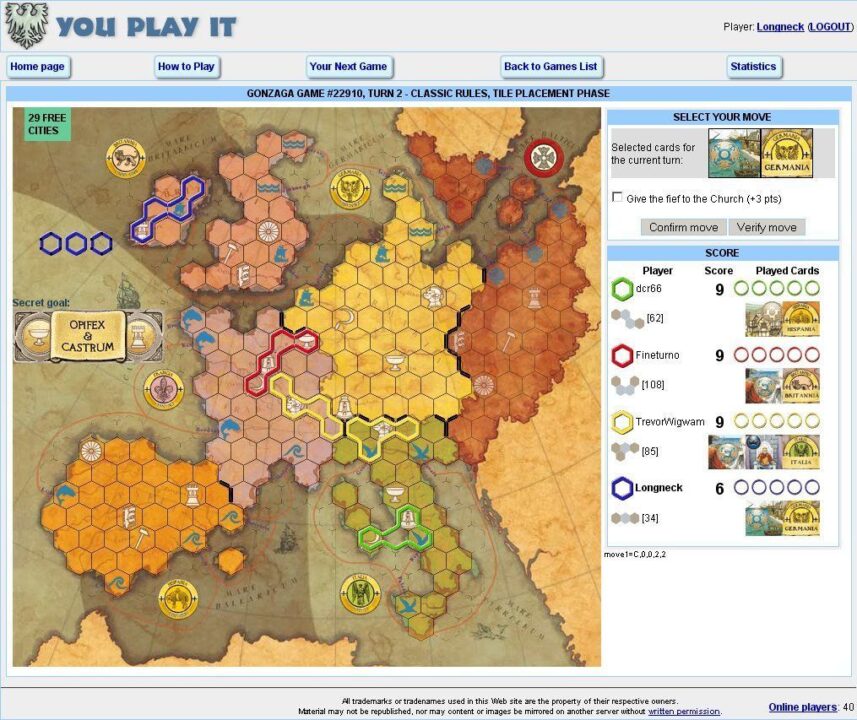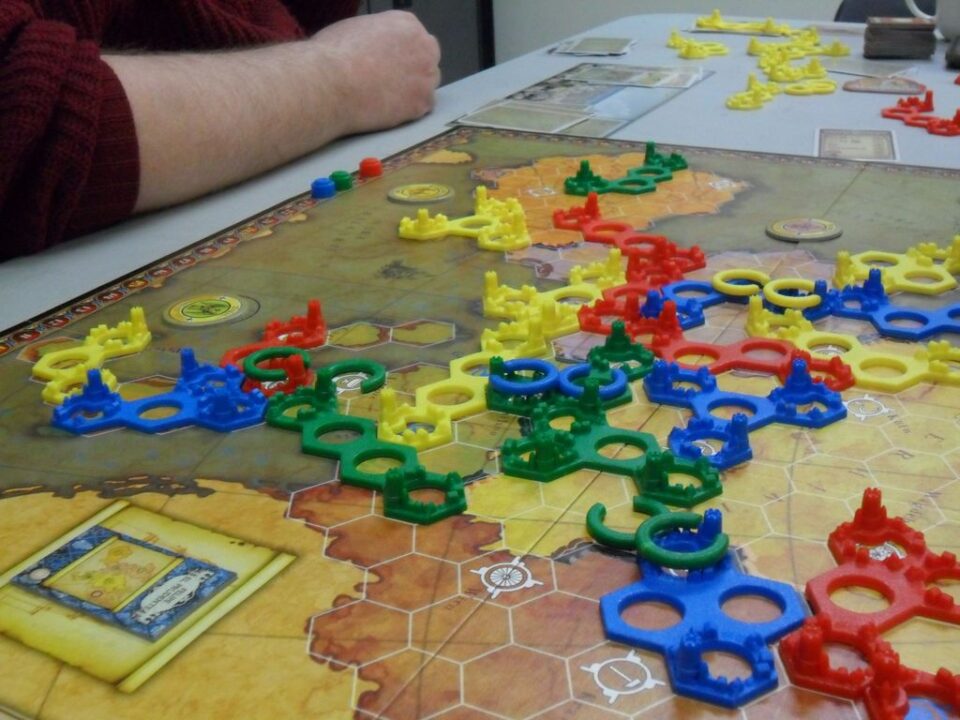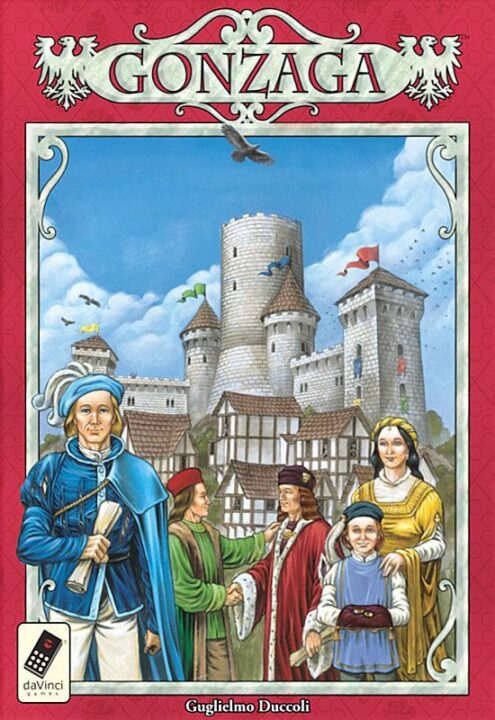Hey there, fellow board gamers! Get ready for a thrilling ride as we embark on a review of Gonzaga. Whether you’re a seasoned strategist or a newbie looking for some board game fun, Gonzaga has something for everyone. We’ve played, we’ve laughed, and now we spill the beans on what makes this game tick. So, stay tuned for an honest, entertaining look at what Gonzaga brings to the table!
How It Plays
Setting up
First, unfold the map board and place it in the center of the table. Each player gets a set of pieces in their color, including route markers and city discs. Shuffle the mission cards and deal three to each player. These cards will guide your strategic moves. Also, place the goods tokens within reach of all players.
Gameplay
Players plan their routes across the map by placing route markers. Everyone does this simultaneously, meaning you’ll have to keep an eye on what others are doing while plotting your own moves. The mission cards determine where you need to establish your routes and cities. Each round consists of two phases: planning and execution. In the planning phase, you secretly choose a mission card. During execution, you reveal your card and place your route markers and city discs accordingly. Beware! Blocked routes can mess with your plans, making player interaction key.
Winning the game
The game ends after a set number of rounds, usually decided before starting. Players then tally up their points based on completed routes, goods collected, and missions fulfilled. The player with the highest score wins the game. If there’s a tie, the player with the most goods tokens takes the crown.
Want to know more? Read our extensive strategy guide for Gonzaga.
Gameplay Mechanics and Strategy
Gonzaga is like a love letter to strategy lovers. You see, in Gonzaga, you don’t just roll some dice and hope for the best. Oh no, there’s a whole lot of brain juice required here. The gameplay revolves around area control and route building, keeping you on your toes from start to finish. You have these transparent pieces that you place on the board to claim routes and territories. Think of it like a game of Risk but without someone flipping the table after losing Australia.
One of the neatest mechanics is simultaneous action selection. You and your buddies pick secretly what you will do next. Then, you all reveal your choices at once. The tension is real, folks. This means you have to guess what others are up to and act accordingly. It’s like a high-stakes game of poker but with fewer bluffing faces and more colored pieces.
The balance in Gonzaga is quite right. Everyone starts on equal footing, and the real challenge is how well you can outthink the others. Just remember, this isn’t a game where you can get by on luck. No sir, your strategies and decisions shape your fate here. I had a blast trying to predict my friends’ moves and blocking their routes just in time. And when they blocked mine? The look on my face must have been priceless.
Strategy aficionados will get a kick out of Gonzaga as it tests your foresight and planning skills. Stay tuned because up next, we will check out the game’s Component quality and design. Spoiler: it’s as impressive as a magician pulling a rabbit from a hat.

Component Quality and Design in Gonzaga
Alright, folks, let’s talk about the bits and pieces that make Gonzaga a real eye-catcher on the table. First off, the board itself is a beauty. It’s got a detailed map that’s easy on the eyes and, more importantly, easy to read. Even my buddy Tim, who usually squints at anything more complicated than a Tic-Tac-Toe grid, had no issues.
The game pieces are top-notch. The region cards are sturdy and have a nice finish, so they won’t wear out after a couple of games. The plastic route markers are colorful and just the right size. Plus, they fit together in a satisfying way, which is always a plus. There’s nothing worse than flimsy bits that slide all over the place during gameplay, but Gonzaga sidesteps that problem nicely.
Next up, the design. The artwork on the cards and the board is both thematic and functional. You can tell that a lot of thought went into making everything clear and engaging without causing any visual chaos. The icons are easy to understand, so you spend less time flipping through the rulebook and more time plotting your next move.
And let’s not forget the game box. It’s compact, with a neat insert that keeps everything snug and tidy. No more opening the box to find a jumbled mess of components. It’s also small enough to throw in a backpack, making it great for game nights at a friend’s house or even a weekend trip.
With these fantastic components, Gonzaga feels like a well-crafted piece of entertainment. Now that we’ve covered that, let’s see how all these components mesh together when the players interact.

Player Interaction Dynamics in Gonzaga
Gonzaga turns a regular game night into a battlefield of wits. One of the standout aspects of Gonzaga is how players interact with each other. This is not a game where you can just do your own thing and hope for the best. Oh no, you need to keep an eye on everyone else!
Players are constantly competing for territory. The territorial conflict in Gonzaga is both strategic and ruthless. Picture this: You’ve got your route all planned out, but right before you place your piece, your buddy swoops in and snatches the spot you needed. Cue the dramatic sighs and evil glares! This creates a dynamic where everyone needs to think ahead and be prepared to adapt their plans on the fly.
There’s also an element of prediction. If you can guess where your opponents are going to strike next, you can either block them or adjust your strategy accordingly. It feels a bit like chess, but with a lot more banter and less elitism.
Gonzaga also has a simultaneous action selection. Everyone picks their moves at the same time, which means nobody is ever bored waiting for their turn. Instead, you get these moments of ‘Did you just…? Seriously?’, which add to the fun. This fast-paced dynamic keeps everyone on their toes and makes the game feel alive from start to finish.
Overall, Gonzaga fosters a highly interactive and engaging environment for players. There’s something wickedly enjoyable about outsmarting your friends while laughing through the chaos. Next up, we’ll tackle how Gonzaga stands up to multiple plays and discuss the game length – prepare yourself!
Gonzaga: Replayability and Game Length
What’s up, board game fans? Today, we’re talking about Gonzaga, a game that’ll make you feel like a master strategist! If you’re like me, you love games you can play over and over and still find fun. Gonzaga checks that box, my friends.
The replayability in Gonzaga is strong. Every game feels fresh because of how adaptable the strategies are. Thanks to hidden objectives and a modular board, no two games will play the same. I’ve played it a dozen times with my pals and, trust me, we keep finding new angles to approach the game. You can focus on different strategies, whether dominating the land or outmaneuvering your friends, and it keeps you coming back for more.
Onto game length. Gonzaga is not too long, nor too short. We usually wrap things up in about 60-90 minutes. This is great because it’s long enough to feel epic but short enough that you can fit a couple rounds into a game night. No one likes a game that drags on forever, right?
So, is Gonzaga worth the investment? If you want a game with strong replay value and perfect game length, then heck yes! It’s a keeper. Gather your friends, break out the snacks, and get ready for some strategic fun. Gonzaga doesn’t disappoint. Thumbs up from me!
Conclusion
Well, folks, that wraps up our whirlwind tour of Gonzaga. This game offers a delightful mix of strategy and interaction with top-notch components. The blend of route-building and simultaneous actions ensures you stay on your toes from start to finish. While no game is without flaws, Gonzaga manages to keep them minimal. Its perfect game length and high replayability make it a keeper in any game collection. So, if you’re looking for a strategic challenge that won’t leave you snoozing, give Gonzaga a whirl!


